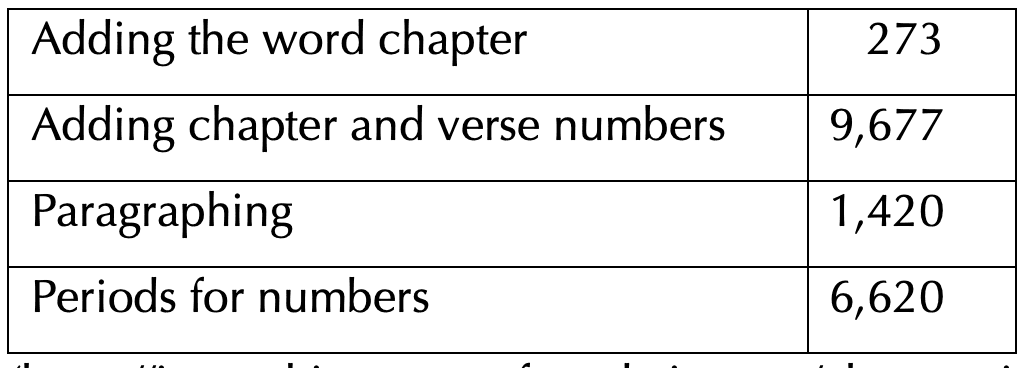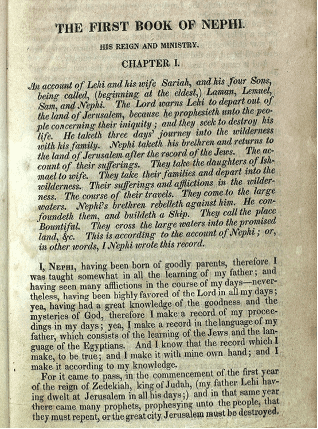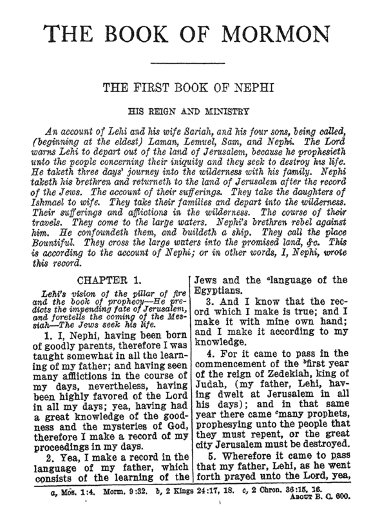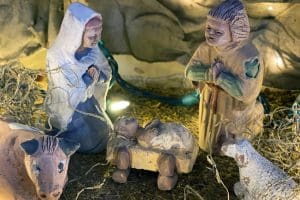Many Protestant and Catholic churches teach that because the Bible is the word of God, it is inerrant, meaning without error. Most, if not all, believe the canon is closed, meaning there will be no more scripture. The doctrine regarding scripture in The Church of Jesus Christ of Latter-day Saints is distinct in three ways:
- We do not believe scripture is inerrant. “We believe the Bible to be the word of God as far as it is translated correctly; we also believe the Book of Mormon to be the word of God” (Article of Faith 8).
- We do not believe in a closed canon. “We believe all that God has revealed,all that He does now reveal, and we believe that He will yet reveal many great and important things pertaining to the Kingdom of God” (Article of Faith 9).
- We do believe, as Joseph Smith taught, the Book of Mormon is the most correct book. “Most correct” refers to doctrine, its precepts, not spelling, punctuation, formatting, or human error. Moroni alerted readers to the possibility of human error on the title page of the Book of Mormon: “And now, if there are faults they are the mistakes of men.”
Even though this is our doctrine, in 1980, some members had a testimony meltdown when 3,913 changes that had been made to the text of the Book of Mormon were published in an anti-Mormon book. However, the apostate couple who wrote the book admitted on page 131: “Most of the 3,913 changes which we found were related to the correction of grammatical and spelling errors and do not really change the basic meaning of the text” (Jerald and Sandra Tanner, The Changing World of Mormonism, Chicago: Moody Pres., 1980, p 131).
Antichrists are nothing new. The first antichrist we know of, Lucifer, started a war in the premortal world when Jesus Christ was chosen to be our Savior. The war continued in the Garden of Eden and has been unrelentingly fought to thwart the Father’s plan and destroy faith in Jesus Christ in every dispensation. If you want to hear antichrists’ arguments, read about Korrihor in Alma 30, Sherem in Jacob 7, and Nehor in Alma 1 in the Book of Mormon. Today’s antichrists use the same pattern of deceit, with the advantage of advanced technology. They use speculations, exaggerations, myths, lies, misquotes, distorted facts, and cherry-picked history to destroy testimony in the Book of Mormon.
Along with antichrists, another type of modern-day enemy has counterparts in the Book of Mormon. Gadianton, Giddianhi, Kishkumen, and Zemnarihah were members of secret combinations whose purpose was to overthrow the Nephite religion and government. Today, evil men and women are likewise, secretly and openly, warring against the family, the Constitution, and religion.
The Lord said to Joseph Smith: “I will give unto you a pattern in all things, that ye may not be deceived; for Satan is abroad in the land, and he goeth forth deceiving the nations” (Doctrine and Covenants 52:14, italics added). This is the Lord’s pattern to protect your testimony and eternal soul. Pray, have a contrite spirit, obey His ordinances, “bring forth fruits of praise and wisdom,” tremble under His power, and speak meek and edifying words (Doctrine and Covenants 52:14-19). Plant the seed of truth and nourish it. Use trusted sources to answer questions in prayer, scriptures, gospel topics essays (churchofjesuschrist.org), and at fairlatterdaysaints.org.
Follow the pattern of antichrists and “secretcombinationites” by not praying, having a haughty spirit, disobeying His ordinances, spreading doubt, thriving on others’ doubts, reading anti-Mormon books and articles, and listening to or watching their podcasts and shows. Like pornography, it is addictive and subversive.
Below, you will find the who, when, how, and why of changes made to the text of the Book of Mormon. I hope this article and others like it will inoculate you against this insidious danger “that when the devil shall send forth his mighty winds, yea, his shafts in the whirlwind, yea, when all his hail and his mighty storm shall beat upon you, it shall have no power over you… because of the rock, (Jesus Christ) upon which ye are built, which is a sure foundation, a foundation whereon if men build they cannot fall” (Helaman 5:12).
Formatting Changes made to the Book of Mormon.
 (https://journal.interpreterfoundation.org/changes-in-the-book-of-mormon/).
(https://journal.interpreterfoundation.org/changes-in-the-book-of-mormon/).
You will see these formatting changes below in the first pages of the 1830, 1879, 1920, and 1981 editions.
1830

The first edition Book of Mormon was not divided into verses but into very long chapters. First Nephi chapter one is sixteen pages long. What was one chapter then is now five. Every time the word chapter was added, it is counted as a change to the original text.
1879

Elder Orson Pratt divided the chapters into smaller chapters and added verses for easier reference. He patterned the changes after the King James Bible. His numbering system became the standard for all future Latter-day Saint editions. Note the first footnotes and indented verse numbers. Changes made the text more readable.
1920

Some sources give Elder James E. Talmage credit for the changes to the 1920 edition, but he had a committee of Apostles to help—George F. Richards, Anthony W. Ivins, Joseph Fielding Smith, and Melvin J. Ballard. “They made grammatical adjustments, standardized the titles of the books of Nephi to remove ambiguity, and put the text in a double-column format to match the presentation of the Bible. They also created chapter summaries for every chapter, included a guide for pronouncing names in the Book of Mormon, added a table of contents, and revised the footnotes and the index” (https://www.churchofjesuschrist.org/study/manual/about-the-scriptures/history?lang=eng#title21). Changes made the text more readable.
1981

The 1981 edition of the Book of Mormon was more than just another edition. Some years previously, a committee was called to harmonize the standard works. This committee worked under the direction of members of the Quorum of the Twelve Apostles. A new footnoting system that cross-linked to the Old and New Testaments, the Doctrine and Covenants, and the Pearl of Great Price was added. New chapter summaries were written to be more descriptive, explanatory, and interpretive. They also added a short introduction to the Book of Mormon and Joseph Smith’s testimony. In 1982, the subtitle “Another Testament of Jesus Christ” was added. Changes made the text more readable.
Punctuation Changes
There was no punctuation in the original or printer’s manuscripts. John Gilbert, the employee of E. B. Grandin who added punctuation as he typeset, made over 41,614 changes. Mr. Gilbert was highly skilled but made some errors that were corrected in subsequent editions. For example:
- “One of the bigger errors occurred on the title page, which includes the preface…. Without any punctuation and not understanding the history or content of the Book of Mormon, Gilbert broke the paragraphs in the wrong place, disconnecting ‘the book of Ether’ from ‘the people of Jared.’ This was corrected in the 1837 edition” (https://history.churchofjesuschrist.org/content/museum/the-book-of-mormon-from-manuscript-to-press?lang=eng#).
- “Oliver’s handwriting also presented a special challenge to the typesetter. His R… and his N are difficult to distinguish, as are his B and So in the first edition, Gadianton was mislabeled ‘the nobler,’ rather than ‘the robber.’”
- In a similar way, the typesetter apparently mistook Oliver’s RM as So in 1 Nephi 13, where the original manuscript read formation, the typesetter misread founation. Then, thinking the letter d had been left out, he supplied it. In the 1981 edition, foundation has been corrected back to read formation, as originally intended” (ibid).
![]()
Spelling Changes
- “Many other spelling errors appear to have been strictly typographical for example,aaswer, amog, bacause, daghter, mnltitude, theit, and
- “Thousands of errors occurred with phonetic spellings: adhear, adultry, babtized, befal, burthensome, centre, condescention, devlish, fraid, phrensied,and Phonetic spellings were common during the time of the translation (ibid).

Grammatical Word Changes (examples, not a complete list):
- which to who 891 times
- was to were 162 times
- that was deleted 188 times
- is to are 74 times
- done to did 10 times
- straight to strait 10 times
- exceeding to exceedingly 177 times
- the was deleted 48 times
- it came to pass was deleted 46 times
- a and an were deleted 40 times
- spelling out “and” in place of an ampersand (&) made 15,577 changes (https://journal.interpreterfoundation.org/changes-in-the-book-of-mormon/#:~:text=). (The Book of Mormon: The Earliest Text, Royal Skousen, introductory pages.)
Typographical Errors
Every book has typos. I remember reading that a book should have no more than three errors per ten thousand words to be considered professional. Errors in fiction don’t matter that much, but we expect scripture to be error free. Though scripture comes from God, the moment a human touches it, errors are inevitable. “Though it is the most important book in the religious life and culture of the English-speaking world, the King James Bible or Authorized Version of 1611 has never been perfectly printed,” wrote David Norton, a professor at Victoria University” (https://newsroom.churchofjesuschrist.org/article/understanding-the-process-of-publishing-the-book-of-mormon).
![]()
Clarifications Made by Joseph Smith
As Joseph edited the printer’s manuscript in 1837, he handwrote on the printer’s manuscript some changes to make the text clearer:
- To 1 Nephi 2:6 he added, “by the side of” to “in a valleya river of water.” It now reads: “in a valley by the side of a river of water.”
- To 1 Nephi 8:4, Joseph added the phrase “in my dream,” to “a dark and dreary wilderness” to remind readers that Lehi is experiencing a dream: “I sawin my dream a dark and dreary wilderness.”
- To 1 Nephi 11:18, 1 Nephi 11:21, 1 Nephi 11:32, 1 Nephi 13:40, Joseph added “of the son” to the middle of “the mother of God.” It now reads: “the mother of the Son of God.” He made this change four times early on in the Book of Mormon but didn’t make the change later on. Dr. Royal Skousen, who is the expert on changes to the Book of Mormon, said: “I view these four changes as examples of clarification rather than doctrinal revision” (https://journal.interpreterfoundation.org/changes-in-the-book-of-mormon/).
Joseph also handwrote a change to the 1840 edition that some feel was a recent, politically-motived change because it didn’t show up until the 1981 edition. The change is “white and delightsome” to “pure and delightsome.” “This change was originally made in the 1840 edition but because subsequent editions were based off the European editions (which followed the 1837 edition), the change did not get perpetuated until the preparation of the 1981 edition. The change is not (as the critics want to portray it) a “recent” change designed to remove a “racist” original” (https://www.fairlatterdaysaints.org/answers/Book_of_Mormon/Textual_changes/%22white%22_changed_to_%22pure%22#).
It seems very likely when Joseph was proofreading this passage by the gift and power of God that the Spirit highlighted the fact that no one can change his or her skin color. What everyone can do is repent and become pure. “Being ‘white’ (or ‘pure’) and ‘delightsome’ in the eyes of God therefore has nothing to do with skin pigmentation or ethnicity, but rather with spiritual and moral uprightness or personal and collective holiness” (https://knowhy.bookofmormoncentral.org/knowhy/what-does-it-mean-to-be-a-white-and-delightsome-people#footnote12_nn3tbb6). Restating: “In 2 Nephi 30:6, white appeared in the 1830 and 1837 editions. Joseph changed this word to pure in the 1840 edition. But later American editions did not show this change because they had followed the first European and 1837 editions. This correction by the Prophet has finally been restored in the 1981 edition” (ibid).
One confusing change is that Benjamin, as in King Benjamin, is twice changed to Mosiah. Joseph made the first change to Mosiah 21:28 in 1837, and Orson Pratt made the second change in Ether 4:1 in 1849. I think it is likely that Orson Pratt, a mathematician, somehow convinced Joseph that he had mixed up the names, figuring that Benjamin could not have lived that long. Either way, a mistake was made.
I made a mistake recently. My second book on evidences of the Book of Mormon was published in October 2023. About a month later, I got a text from a gospel scholar telling me I had made a serious mistake. I checked and he was correct, which caused me to doubt my ability to do accurate research. I went back to my manuscript and found that what was left out of the book was in my final manuscript. I had made a clerical error rather than flawed research. However, I am positive there are more clerical errors and some research errors too because life interferes with my writing.
This is how it goes. I sit down to write a paragraph and the phone rings. After a while, I get back to writing. It takes a few minutes to recover my train of thought, and I write another sentence or two. Then the clothes dryer buzzes. I fold the clothes, and go back to my computer. Then I realize it’s lunch time. After lunch I run an errand. When I get home, I start to write again and soon it is time for dinner. These trivial interruptions cause me to lose focus, ideas, and words. Things fall through the cracks. I make mistakes; some I catch; some I don’t.
From reading Joseph’s history, I know he experienced major interruptions: burying a newborn son, caregiving a gravely ill wife, losing the Book of Mormon manuscript, experiencing such intense persecution that he had to move from Palmyra, New York to Harmony, Pennsylvania, to Fayette, New York to finish the Book of Mormon. How could he not make mistakes working with almost 270,000 words, 337 of which are proper names?
More importantly, the Book of Mormon and the prophetic calling of Joseph Smith are not independent from each other. Heavenly Father chose Joseph. The Book of Mormon came through him and part of that prophetic calling would include finding errors and correcting them. Only he knows the awe of the First Vision and the voices of God the Father and Jesus Christ. Only he knows the conversations he had with Moroni. Only he knows what it was like to read words on the Urim and Thummim and dictate to a scribe. Only he knows how the powers, gifts, and mercies of God that empowered him to restore the gospel of Jesus Christ.
Joseph made changes to the Book of Mormon under the Lord’s direction, which was his duty, right, and responsibility. Trust the Prophet. Safeguard your testimony.


















